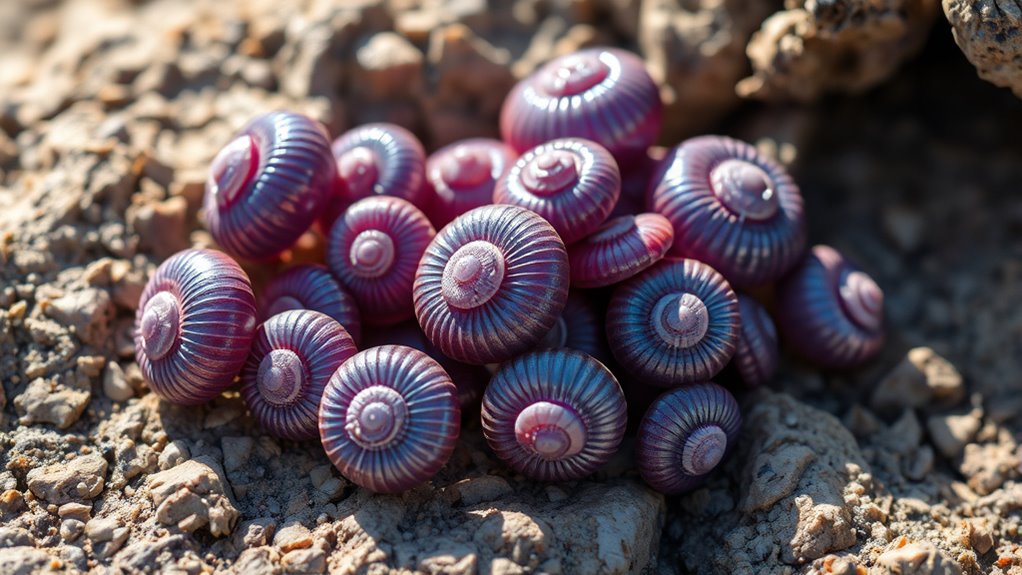Roman purple, the world’s most valuable dye, was made from the hypobranchial glands of murex sea snails. The process was complex, involving harvesting large quantities of snails, extracting tiny amounts of secretion, and exposing it to sunlight to develop its vibrant purple color. This dye symbolized power, wealth, and imperial status in ancient times. To discover more about the fascinating history and significance of this legendary pigment, keep exploring further.
Key Takeaways
- Roman purple dye, known as Tyrian purple, was extracted from the hypobranchial gland of certain sea snails, primarily murex species.
- The dye production was labor-intensive, requiring large quantities of snails to produce small amounts of the precious pigment.
- When the snail secretion was exposed to sunlight and air, it transformed into a vibrant purple color.
- Its rarity and cost made Roman purple a symbol of wealth, power, and imperial status in ancient societies.
- Modern reproductions use traditional or synthetic methods to emulate the historic dye’s rich hue and cultural significance.
The Myth and History Behind Tyrian Purple
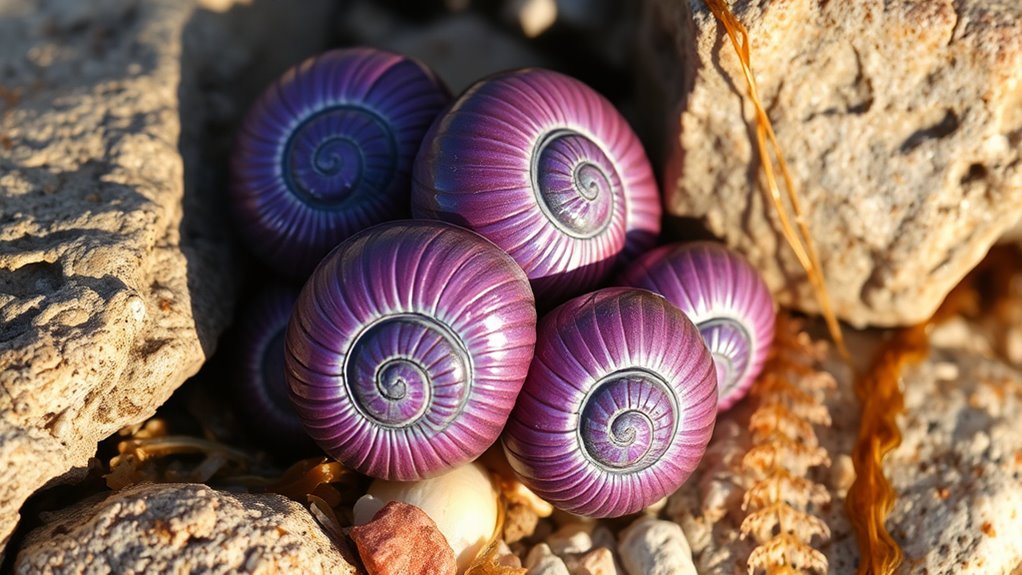
Though the origin of Tyrian purple is shrouded in myth, it’s clear that this vibrant dye held immense cultural and economic significance in ancient times. Mythical origins often link it to gods and legendary stories, emphasizing its divine and mysterious nature. Its royal associations run deep, as only the elite could afford this luxurious hue, symbolizing power and prestige. Ancient civilizations believed Tyrian purple was a gift from the gods, further elevating its status. Its rarity and the difficult process of production made it a coveted commodity, often reserved for emperors, kings, and high priests. The production process involved extensive labor and specialized skills, underscoring its exclusivity. This mythical aura, combined with its real historical importance, cemented Tyrian purple’s reputation as the most prestigious dye of the ancient world.
The Murex Snail: Nature’s Purple Producer
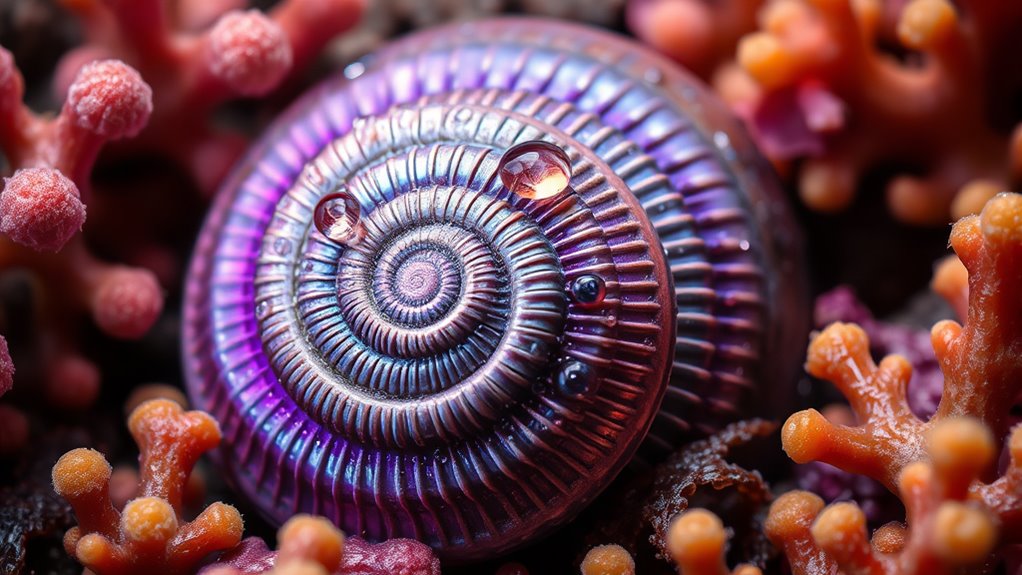
Have you ever wondered how ancient civilizations produced their stunning purple dye? It all starts with the Murex snail, a sea creature that thrives in warm, coastal waters around the Mediterranean. You’ll find these snails in rocky, shallow habitats, where they cling to shells and coral. When the Murex is disturbed, it releases a secretion that contains the dye precursors responsible for purple hues. The dye chemical properties are remarkable: when exposed to sunlight and air, the secretion transforms into a vibrant purple pigment. This process, unique to the Murex snail’s biology, makes their hemolymph the source of the world’s most valuable dye. Their habitat, combined with their specialized chemical makeup, allowed ancient artisans to produce the coveted purple color that symbolized royalty and power. Additionally, the snails’ habitat preferences influence their distribution and the ease with which ancient peoples could harvest them for dye production.
The Elaborate Process of Extracting Dye
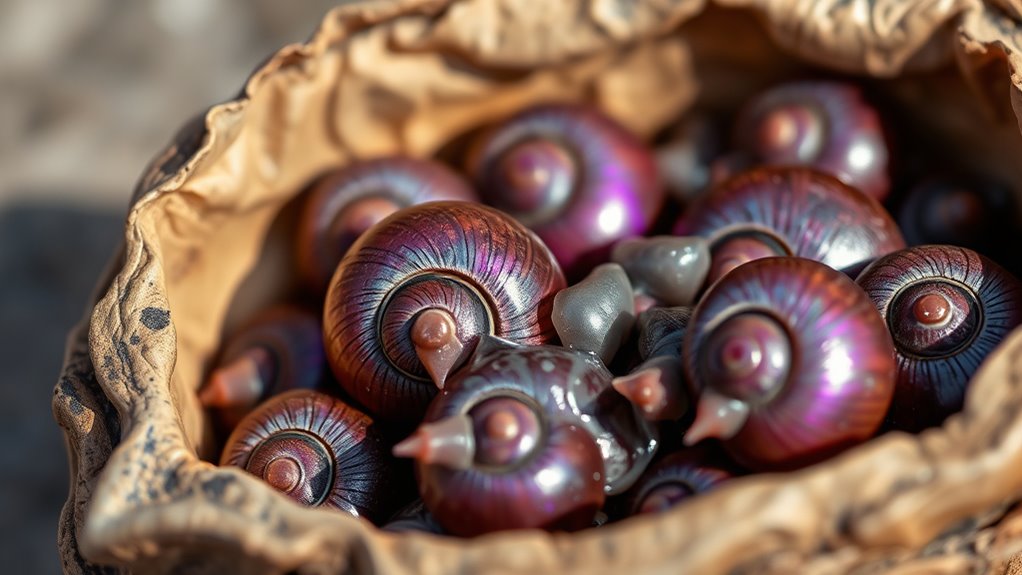
To extract the vivid purple dye from the Murex snail, artisans had to undertake a complex and labor-intensive process. First, they carefully harvest the snails, knowing each one holds a tiny amount of dye. Then, they crack open the shells to access the hypobranchial gland, where the dye precursor resides. This dye extraction requires patience, as thousands of snails yield only a small amount of dye. The process involves collecting and processing the gland material, which is then exposed to sunlight or heat to develop the deep purple hue. This meticulous effort underscores the value placed on the dye. Proper dye extraction techniques and understanding the biology of the snail are essential for successful production.
Wealth and Power Symbolized by the Color
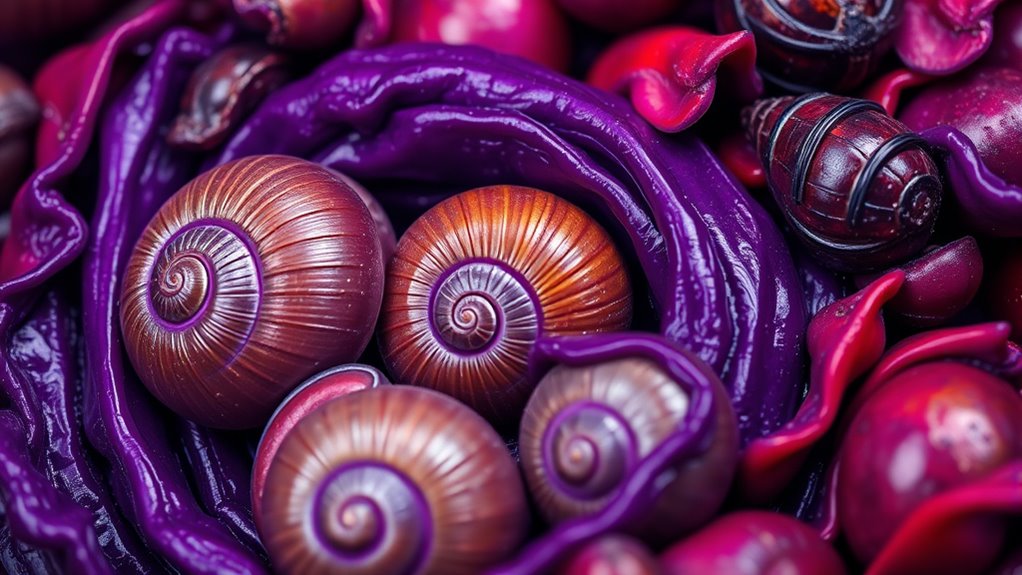
When you see Roman purple, you’re looking at more than just a color—it’s a sign of imperial status. Its rarity and cost made it a symbol of wealth and power reserved for the elite. Wearing or displaying purple signified your high rank and influence in Roman society.
Imperial Status Symbol
Roman purple became a powerful symbol of imperial status because it was so rare and expensive to produce, making it the color of choice for emperors and high-ranking officials. Its scarcity stemmed from the complex ancient trade routes that supplied the dye, which required thousands of snails and extensive processing. Wearing purple signaled wealth and authority, as only royalty and elites could afford such luxury. In royal fashion, the color distinguished rulers from common citizens, emphasizing their elevated position. The exclusivity of Roman purple reinforced social hierarchies and imperial power. By donning this distinctive hue, leaders communicated their dominance and divine right to rule, cementing purple’s role as a visual marker of wealth and authority throughout the empire. Additionally, the dyeing process involved intricate techniques that underscored its value and the craftsmanship behind its production.
Exclusive and Expensive
Have you ever wondered why purple clothing has long been associated with wealth and power? The answer lies in its status as an extremely exclusive and expensive dye, once reserved for royalty and high aristocrats. This rarity came from the complex ancient craftsmanship needed to produce it, involving countless snails and meticulous processing. The color’s symbolism extended beyond fashion, representing authority and prestige across civilizations. When you see purple garments in history, they’re not just stylish—they’re symbols of immense wealth. Its high cost kept it out of reach for most, making it a powerful marker of social hierarchy. Today, purple still evokes luxury and exclusivity, rooted in centuries of tradition and craftsmanship. The process of creating the dye was so labor-intensive that it became a symbol of wealth, further reinforcing its status as a luxury item. It’s a color that speaks volumes about power, privilege, and status.
The Decline and Legacy of Roman Purple
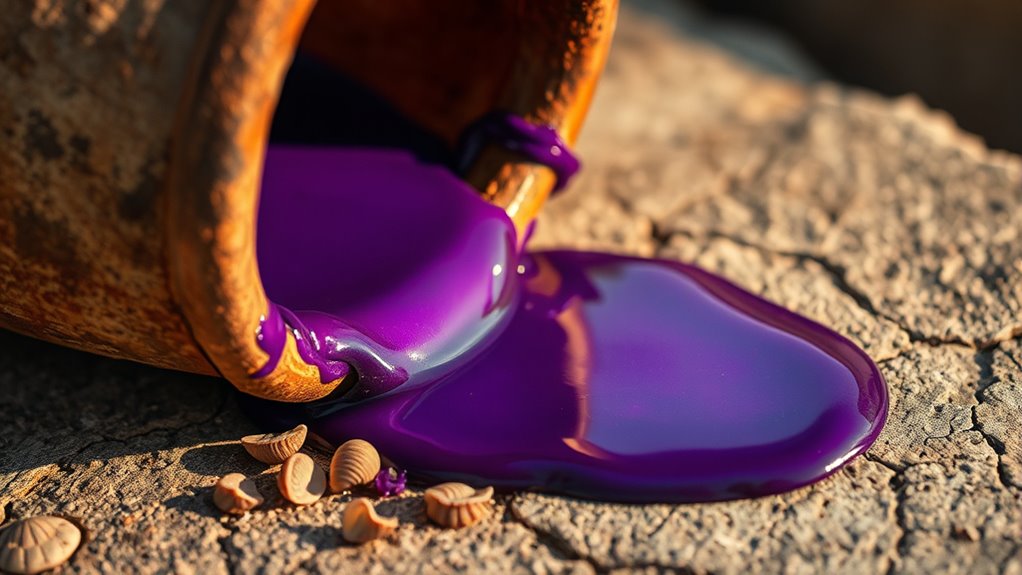
Despite its dazzling prestige, the prominence of Roman purple gradually faded as the empire declined and political priorities shifted. As Roman authority waned, the dye industry struggled to maintain its supply of the precious snail dye. During medieval trading, the demand for purple persisted, but other sources and techniques began to replace the costly snail-derived dye. The decline of Roman purple meant fewer merchants and artisans focused on its production, and its exclusivity diminished. Over time, the rarity that once made it a symbol of imperial power gave way to more accessible dyes. Today, the legacy of Roman purple endures through historical influence, inspiring modern recreations and cultural significance, but the original dye’s dominance in history is forever linked to the rise and fall of the Roman Empire. The types of headphone jacks and the techniques used to produce the dye reflect a similar evolution from exclusivity to accessibility over centuries.
Modern Replications and the Cultural Significance

Today, modern dye techniques allow us to recreate Roman purple with remarkable accuracy, making ancient craftsmanship accessible again. These efforts play a key role in preserving cultural heritage and celebrating historical artistry. By exploring these replications, you can gain a deeper appreciation for the significance behind this regal color. Understanding the authenticity of vintage dyes is crucial to appreciating the true depth and richness of Roman purple.
Contemporary Dye Techniques
How do modern dye techniques recreate the ancient allure of Roman purple while respecting its cultural roots? Today, artisans use natural fermentation processes to produce authentic shades reminiscent of historical dyeing, emphasizing sustainability. Some also utilize synthetic dyes that mimic the deep, vibrant hues of Tyrian purple, making production more accessible. These techniques preserve the cultural significance by blending tradition with innovation. Additionally, asset division strategies can be employed to ensure fair distribution of resources and maintain cultural heritage.
Cultural Heritage Preservation
Have modern replicas of Roman purple succeeded in preserving the cultural significance of this ancient dye? While synthetic versions make the color more accessible today, they often lack the historical depth tied to medieval textiles and royal fashion. Authentic Roman purple represented power, wealth, and prestige, especially among elites and monarchs. Replications help keep this symbolism alive, but they can’t fully capture the dye’s original cultural weight. Museums and artisans work to recreate the dye using traditional methods, emphasizing its importance in preserving heritage. These efforts allow us to appreciate the dye’s role in history and its influence on royal fashion. Ultimately, modern reproductions serve as tangible links to the past, helping us honor and remember the cultural significance that Roman purple once held. Additionally, resources and tools such as specialized dyes and historical techniques are used to enhance authenticity in modern recreations.
Frequently Asked Questions
How Did Tyrian Purple Influence Ancient Trade Routes?
You see, Tyrian purple greatly impacted ancient trade routes because it was highly prized and rare. Its dye extraction from marine biodiversity, specifically snails, made it valuable and sought after across civilizations. As demand grew, trade expanded, connecting distant regions. You’d notice merchants traveling long distances to acquire this dye, which influenced the development of trade networks, economies, and cultural exchanges around the Mediterranean and beyond.
Are There Any Living Species Related to Murex Snails Today?
Did you know there are still living species related to Murex snails today? These Murex relatives, part of the Muricidae family, include over 1,500 species worldwide. You can find them in warm, rocky coastal waters. These snails share many characteristics with ancient Murex, making them fascinating for scientists studying marine biodiversity. So, yes, your curiosity about living Murex relatives is well-founded—they’re still swimming in today’s oceans!
What Environmental Impacts Did Ancient Dye Production Cause?
You might wonder about the environmental impacts of ancient dye production. When dyeing with mollusk shells, such as murex snails, there was significant ecological disruption and resource depletion. Large-scale harvesting of snails to extract dye caused habitat damage and reduced snail populations. This intensive collection strained local ecosystems, leading to long-term environmental consequences, and highlighting how ancient industries impacted natural resources more than we often realize.
How Did Roman Purple Affect Social Hierarchies Worldwide?
You recognize that purple dye, especially Roman purple, played a key role in social stratification and imperial symbolism worldwide. When you see someone wearing it, you understand it signified wealth, power, and high status. This color became a symbol of authority, often reserved for rulers and elites, reinforcing social hierarchies across cultures. Its rarity and expense kept it exclusive, making it a powerful tool for maintaining social distinctions.
Can Modern Synthetic Dyes Truly Replicate Tyrian Purple’S Qualities?
You might wonder if modern synthetic dyes can truly replicate Tyrian purple’s qualities. Investigating this, it’s clear that while synthetic dyes can mimic the chemical composition, they often fall short in dye longevity and depth of color. Tyrian purple’s unique molecular structure gives it a richness and durability that many synthetics struggle to duplicate. So, despite advancements, true replication remains challenging, preserving the dye’s legendary status.
Conclusion
Now, imagine standing amidst a sea of history, where tiny snails spun threads of royal purple that once cloaked emperors and gods. Their secret, hidden in shells, transformed simple creatures into symbols of power and prestige. Though the true dye faded into myth, its legacy colors our world today, reminding you that even the smallest beings can weave the grandest tapestries of history—forever leaving their vibrant mark on time’s vast canvas.
